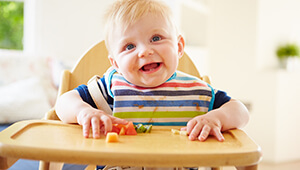At the Table


Now that your child has passed the 12-months mark, you can integrate him into regular mealtimes. His teeth are coming in so he can chew finely chopped adult fare, and his improved motor skills mean that he can eat on his own, freeing you from having to spoon every morsel into his mouth.
You’ll be able to relax and enjoy your own meal, and your baby will love being part of a family activity. Donna Savage, a director of communication from Wilton, Conn., remembers that her daughter Sophia first showed signs of appreciating the nightly dinner ritual at about one year. “She was in her high chair, watching me bring dishes to the table,” Savage remembers. “She kicked her little feet in excitement, knowing that supper was about to begin.”
To help you bring your baby to the table, our experts describe her new nutritional needs and ways to make the experience as easy as possible on everyone.
What’s for dinner?
To determine what should be on a one-year-old’s plate, start by considering his calcium requirement, which is 500 milligrams a day, or the equivalent of about two cups of milk, advises Stephanie Smith, a Denver nutritionist. Whole milk should be served to children two and younger, in order to ensure that their diet includes enough fat for early brain development. Two cups of milk also help satisfy some of the protein requirements of one-year-olds, and an ounce of meat fulfills the rest.
The remainder of the daily food intake should be drawn from the other major groups: three to four two-tablespoon servings of fruits and vegetables, and four servings of grains, including whole grains (a single serving equals a tablespoon of cooked grain or a quarter slice of bread).
Timing is everything
Your goal is to feed your baby three meals plus two or three snacks each day, says Terri Verason, a registered dietitian in Tempe, Ariz. “Their tummies are little at this age, so they fill up quickly and empty out just as fast,” she says. If dinner will be late, give your child two snacks in the afternoon rather than one before dinner and one at bedtime. Early evening is a fussy time for many 12- to 17-month-olds, and you don’t want to add hunger to the equation.
Variety on the plate
“Bright colors appeal to babies,” says Verason. “As adults, we know that a colorful meal has diverse nutrients, but babies simply appreciate the varied hues.” You might offer combinations, such as carrots and peas or green beans and sweet potatoes. To vary textures, serve mashed vegetables along with chopped ones. Unusual pasta shapes are a favorite with toddlers, as is bread cut into circles, squares or stars.
“You’ll notice that a one-year-old usually doesn’t reuse green vegetables just because of their color, as a toddler might,” says Verason. She notes that the typical two-year-old’s green-veggie aversion is a learned response, probably because they have been presented as mandatory, and avoiding them has become a way to exercise control. To prevent this, she advises, “Don’t make green vegetables an issue, and your child will never know they are one.”
Try, try again
It can take several exposures for a baby to accept new foods. If your child wrinkles her nose at her fist encounter with, let’s say, a peach, keep putting peach slices on her plate along with other more familiar foods. Or mix a new food into an old favorite; for example, you might stir blueberries into her yogurt, or, if your baby happily eats cheese and eggs, incorporate finely chopped spinach into a quiche. Eventually you can change the proportions, adding more of the new ingredients until you’ve eliminated the old ones entirely.
Eating together
Once your child has joined the family at mealtimes, get real about our expectations. “Your responsibility is to set out a variety of wholesome, simple-to-eat foods,” says Smith. “Beyond that, parents shouldn’t place a lot of importance on how much their child eats or how long the meal lasts.” Toddlers are expected to be learning manners, but babies still need to discover what mealtime is about.
Some spills and splatters are inevitable, but managing them doesn’t have to be difficult. Once you’ve created a safe, controlled environment for your child, let her play with her food as she eats it. Babies are curious, and they learn a lot by touching and mouthing things they’d like to find out about. Encourage your child to explore the marvelous things you’ve put on her plate. Then, when her appetite is satisfied, and she has started to fidget, dinner should be over for her.
“If your baby doesn’t eat much supper, so be it,” says Verason, who advises offering a nutritious bedtime snack to a baby who has had a light evening meal. If allowed to “graze” and make his own choices within the healthy options you’ve presented to him, your little one will end up eating a good balanced diet over a period of days, weeks or even months.
Simply coming to the table for a real family meal is a big developmental step for 12- to 17-month-olds. Make it an easygoing experience for everyone, and you’ll encourage healthy eating habits for a lifetime.


